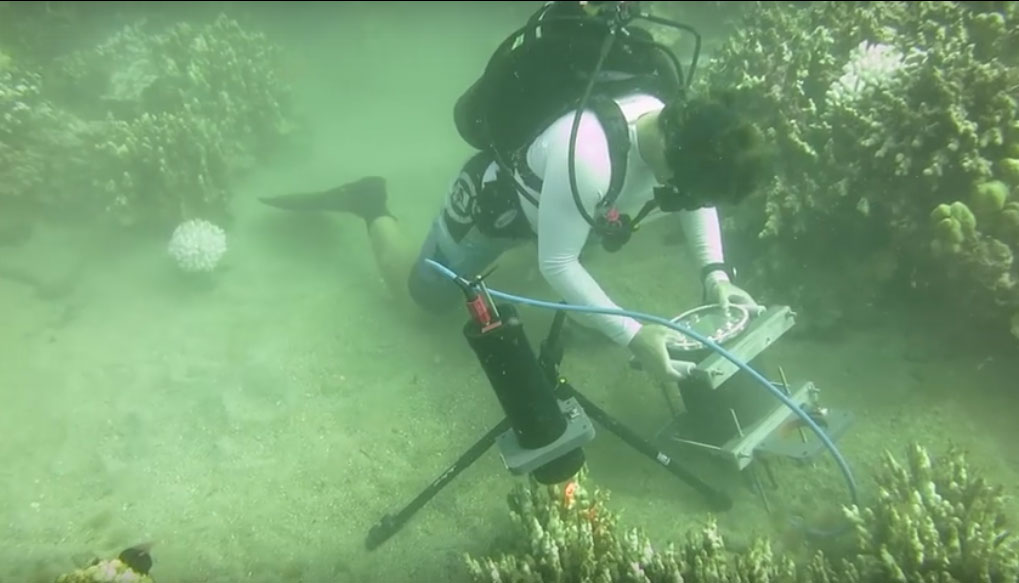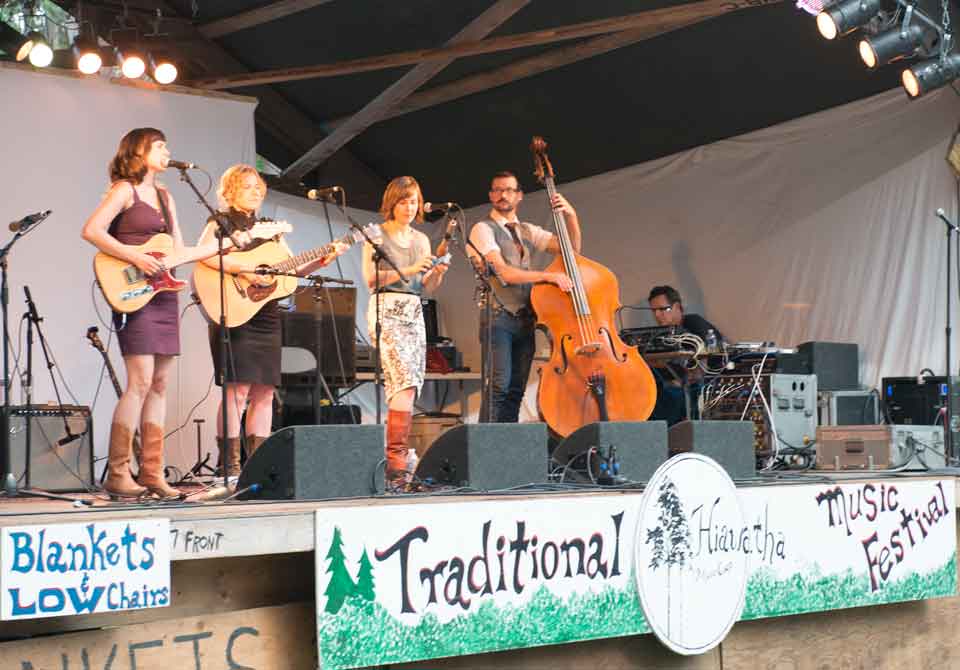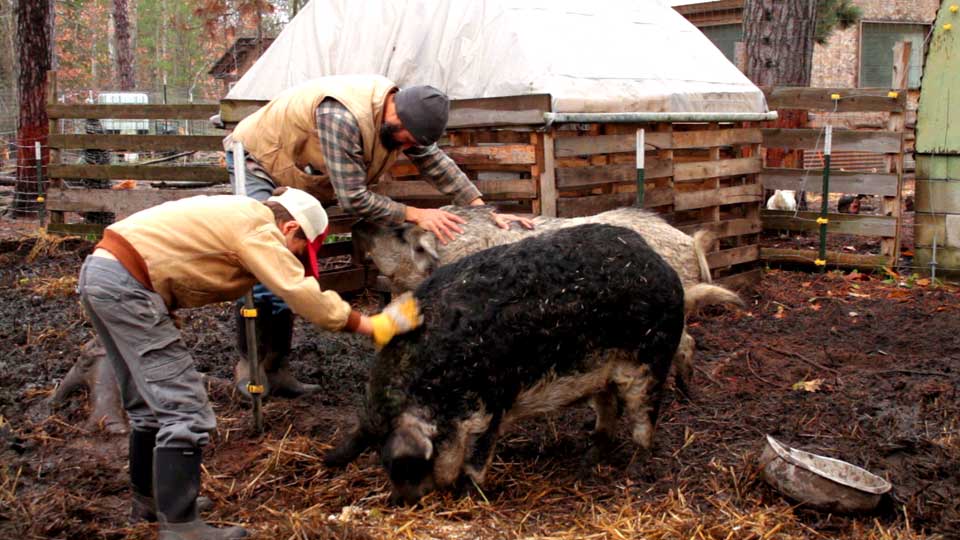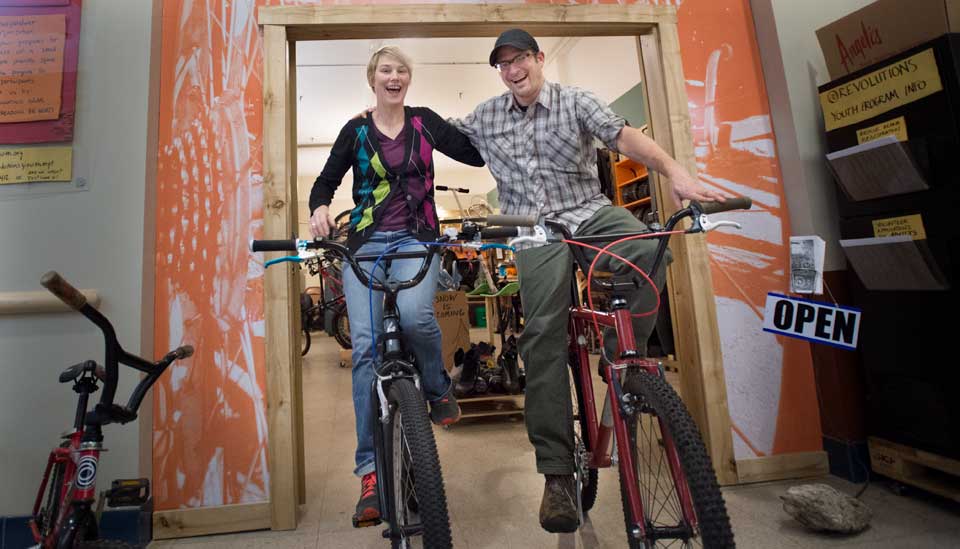How to Get Started in Home Brewing
by David Gill

Marquette Home Brewers club members David Gill (left) and Mark Iocapelli (right) grind grains for homebrewing using simple items found at most any hardware store. (photo by Ron Caspi)
OK, I’m a guy with a lot of hobbies. On a good day, maybe I qualify as being multi-talented, but there are those days when I feel like maybe I’m spread too thin. Of all the hobbies out there, the only one I can think of that I haven’t dabbled in is golf. I have nothing against golf, but between biking, fishing, boat-building, playing guitar, keyboard, and ukulele, various construction projects, cooking, camping, welding, reading, (and did I mention I have a full-time job?) I just don’t think I need another hobby that might turn into a passion. I’m fairly certain my wife would agree. After all, some of these hobbies are expensive to get into, and time-consuming to be involved in. Actually, I take that back. All of them are.
There is, of course, one conspicuous omission from the above list, and if you read the title, you know I am referring to home brewing. Yes, it’s true. I left it off because it really needs to be considered separately from the other hobbies. In fact, home brewing is actually a large and diverse set of many hobbies that go together, making a list as long as the one in the previous paragraph. If you don’t believe me, just listen: Home brewing consists of brewing, of course, but there is also fermenting, building stuff, bottling, kegging, operating a yeast lab, tasting, collecting, traveling, reading, experimenting, designing recipes, bacteriology, hop cultivation, filtration, conditioning, fining, barrel aging, making tinctures, infusions, and more. Bear with me, though, because now I’ll start sharing some of the reasons why home brewing has become such a rewarding part of my life and why it could and should become part of yours.
Bottom line? Among all hobbies, home brewing beer is one of the most satisfying, fun, interesting, social, fascinating activities you can be involved in. Because of home brewing, I have met some amazing friends, learned to appreciate and evaluate craft beers of all styles (I still have a lot more to learn though), traveled throughout Michigan and across the U.S., tasted some craft brews that have opened up new realms of flavor for me, read some fascinating books, participated in experiments, seminars, and conferences, and have had the chance to brew with the pros and see a recipe I formulated served on tap at a local brewery. I have met the local professional brewers and had a chance to see and talk about what they do. More than anything, I have enjoyed forming friendships with other brewers through the Marquette Home Brewers’ club, which I feel you should join immediately if you are thinking of trying the hobby of home brewing. Believe me, it’s more enjoyable in a community of like-minded people, and the opportunities for fun and education are endless.
Truthfully, home brewing need not be expensive or time-consuming when compared to other hobbies. How much does it cost to get involved in golf? Fishing? How about mountain biking? Let’s face it; hobbies are expensive, and later I will show you various ways to get into the hobby of home brewing ranging from a few hundred dollars all the way down to, well, virtually free.

Marquete Home Brewers members learn from one another as they enjoy tasting and talking beer while brewing together. (photo by Ron Caspi)
Did I just say “virtually free?” Well, yes, I did. An annual membership to Marquette Home Brewers costs $24. If you merely attend a meeting and speak some magic words, equipment will be lent to you almost immediately. The magic words are, “Hey, my name is (insert name here) and I would really like to try brewing but I don’t have any equipment yet.” There are plenty of us in the club with enough extra equipment to get you started and we are happy to let new members borrow it. If you don’t want to go it alone, you could always attend one of our monthly “Big Brew Days.” That’s right, several of us brew side by side at least once each month. At a Big Brew Day, you would have the chance to brew your first batch surrounded by helpful and knowledgeable brewers. It’s been done before!
The “inexpensive but not free” route would consist of buying a starter kit like this one for just over $200, which includes absolutely everything you need to brew beer, including bottles, a brew kettle, ingredients and instructions for your very first batch. Or perhaps you have 50 empty beer bottles (not twist-top though) and a 5-gallon kettle at your house already. If that’s the case, then this kit would serve your needs for just over $100. Either of these kits would serve you well for your first year or two, or perhaps even longer if your interest level doesn’t spur you into new realms such as yeast harvesting, brewing lagers, or any of the other “hobbies within a hobby” that I mentioned in paragraph two. But you certainly don’t need to explore any of that in order to enjoy consistently brewing good beer. Where you go in this hobby relies entirely on your own level of commitment, enjoyment, and interest.

A homebrewer stirs grains and water together using a wooden spatula and a portable cooler during an on-location demonstration of home brewing by the Marquette Home Brewers. (photo by Ron Caspi)
A final option for putting together your basic brewing kit is to piece it together yourself using locally available items. This is an option I recommend if you are not intimidated by shopping lists and if, like me, you appreciate supporting local businesses. Most of these items can be found at White’s Party Store in Marquette. The 5-gallon brewing kettle may be tricky to find locally, though I highly recommend using one made of stainless steel and with a nice, heavy bottom to avoid scorching the sugars when you boil. I personally have this kettle, and although I have now outgrown it as a primary brewing kettle, it still serves me for other brewing purposes. So here is your shopping list if you want to put together your own brewing kit:
-
3/8” Plastic Bottling wand
-
Bag of Bottle Caps
-
Bottle Capper (hand-held)
-
Reusable Mesh Steeping bags or cheesecloth
-
Plastic Spoon
-
Funnel
-
6.5-gallon plastic fermenting bucket
-
Plastic Bottling/Sanitation Bucket with Spigot
-
Package of Powdered Brewery Wash (PBW) or One-Step Sanitizer
-
Airlock
-
Rubber Stopper for fermenting bucket with Hole for airlock
-
5ft Vinyl Transfer Tubing, 3/8” Inner Diameter
-
Sterile Siphon Starter (Contains Racking Cane with Tubing, Air Filter and Carboy Hood)
-
Dial thermometer or waterproof digital thermometer
-
2 Cases of (12) 22oz Bottles or 50 12-oz bottles (not twist-top)
-
5-Gallon Stainless Kettle
Helpful but not necessary right away:
-
Hydrometer
-
Hydrometer tube
-
5-gallon glass or plastic carboy (for secondary fermentation, a step you can skip at first)
-
Kitchen scale that weighs in grams and oz.
And there you have it. The hobby of home brewing is one of the most fascinating, rewarding, fun, and enjoyable activities you can get involved in, and there is no end to how far you can go with it. So what are you waiting for? Come on down and join the club, and get brewing! Get yourself a kit or use some of our equipment. There are many events and activities going on in the Marquette Home Brewers every month, and many people to help you get started. The only thing we need is you!














You must be logged in to post a comment Login